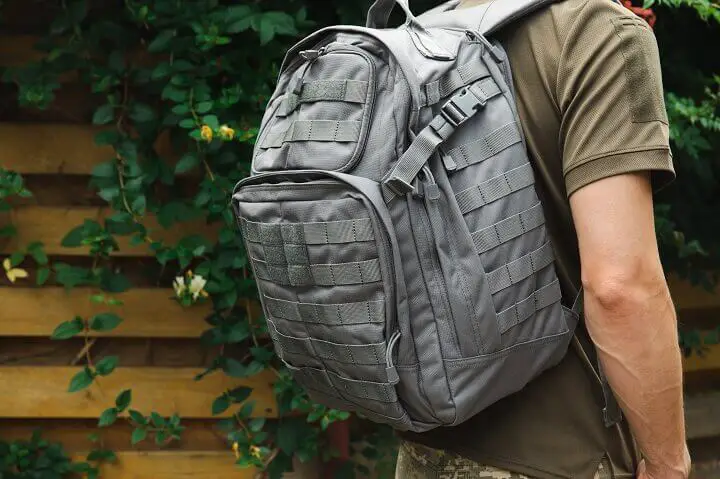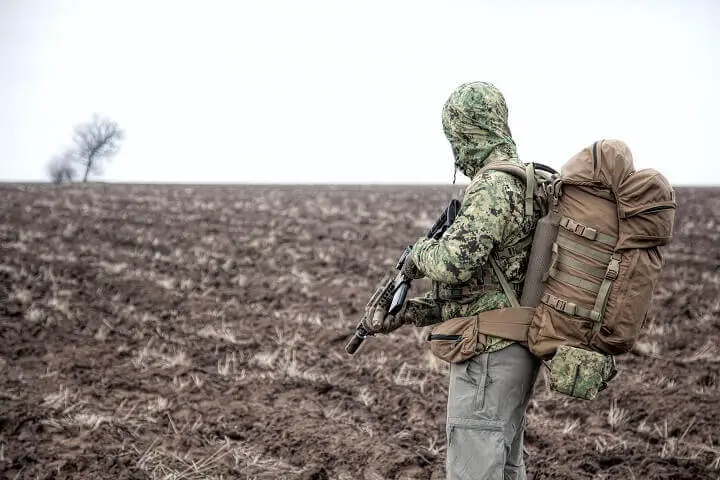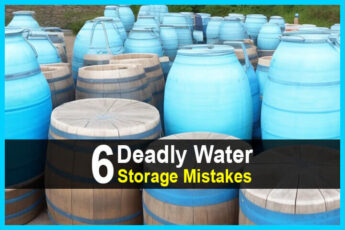Estimated reading time: 13 minutes
Life is as unpredictable as the events that happen within it. When these events become extreme, there may be a need to leave the immediate area as soon as possible and stay away for an undetermined amount of time.
One of the best ways to be prepared for such a scenario is to use a bug out bag filled with supplies to get you through at least the first 72 hours. A good bug out bag is a combination of utility, ease of access, and portability.
If you’re new to this topic, then it may seem daunting, but this article will show you how to build the perfect bug out bag.
Want to save this post for later? Click Here to Pin It On Pinterest!
What is a Bug Out Bag?
A bug out bag is a kit for short-term survival. If you pack it properly, you can get through the first few days without modern luxuries pretty easily.
After that, you'll have to rely on some sort of supply replenishment, whether that be scavenging or purchasing new items. Thinking about these things in advance is a good idea as countries experience natural disasters, supply shortages, and wars all of the time. In fact, without something like a bug out bag, your odds of survival can drop significantly.
Some other names for a bug out bag include a “72-Hour Kit”, a “Get Out Bag”, or even an “Evacuation Pack”. All these names make it clear what the pack is designed to do.
What Separates a Bug Out Bag from Camping Packs?
Some people will compare these two types of packs since they are both designed to have contents that can keep you alive outside of your home environment. A camping pack is designed to give you the bare essentials since you'll more than likely enjoy a calm lifestyle in nature for a short time.
The bug out bag is designed to have essentials that you may need while away from home, including various medications, personal items, and other necessities. Some people even turn their camping packs into bug out bags by adding certain survival items.
Why is Having a Bug Out Bag Essential Today?
Preppers and survivalists understand the need to have various kits ready to go in case you need to bolt. Some people use their bug out bags if they have to make short trips as they have all of the essentials you would need from home.
A bug out bag also gives you a nice feeling of security in being prepared for major disaster, which are becoming more and more common. It means you won’t have to scavenge when things break down and provide a little more control when it comes to decision-making.
When Would You Need a Bug Out Bag?
A bug out bag is not something you take with you daily as it may hold expensive items that you want to save for when they are actually needed. There are a variety of scenarios where a bug out bag may be necessary. For example…
Wildfires
If you’ve heard the saying “spreading like wildfire” and have seen one in real life, then you know that they can come out of nowhere and close in on your home quickly. In a situation where a forest fire is closing in on you, you may not necessarily have the time to run around your house looking for items to take with you.
Wildfire-prone areas will have a fire ban which makes cooking a little tricky. Some people use Flameless ration heaters from MREs to heat their packaged food while others use a small propane stove while keeping it away from dry tinder. Bug out bags are perfect for carrying multiple ways to cook things in these situations.
Having a bug out bag or two will enable you to evacuate quickly and get to safety before it's too late. If your area is subject to wildfires every year, be sure to treat your bag with a fire retardant chemical to ensure the items within stay safe.
Flooding
Flooding is one of the most terrifying natural disasters because of how quickly it can sneak up on you. It can be the result of strong storms, overflowing waterways, and sewers backing up.
Nothing is scarier than seeing a flash flood of water barreling your way. Panicking during a flood can be catastrophic as your thoughts are scattered and you more than likely won’t be able to gather the things you need before it's time to bail.
An easy-to-access bag with all of the vital items can give you the precious minutes you’ll need to evacuate your home. Ensure your bug out bag is dry (made of rubber) so that you don’t have issues with water getting in.

Food and Goods Shortages
Supply shortages, logistical problems, and recalls are some of the ways that shortages affect people in their day-to-day lives. In the event of a major shortage where vital goods are not coming in, you might need to bug out for a bit.
Shortages can lead to desperate times for many, which can increase criminal activity. This means that your home could be compromised with your inventory being pilfered by intruders during rough times. A bug out bag lets you carry the essentials with you, as well as some protection in case you meet some dangerous people on the way out.
War and Invasion
War is a time that shouldn't be wished upon anyone. Chaos, death, and extensive damage can cause extensive trauma, heightened emotions, and fractured thoughts. You’ll never know when you need to leave at a moment’s notice, whether it is from enemy troop engagement, air attacks, or possible bombing in your area.
Having your packs ready to go by your escape route can make an otherwise terrifying and chaotic time easier to navigate since you won’t have to worry about going back to get anything.
Biological Terrorist Attack
We’ve all been through pandemics, lockdowns, and other extraordinary measures in our lifetime. A biological terror attack can devastate a population through widespread contamination of the people.
In an event of something as catastrophic as this, there may be an official warning from authorities to get out of dodge. Since these orders are usually given promptly, you have to act quickly and get anything you need. This is where a bug out bag shines, providing all of the necessary food, water, and medications for you and your family.
What Should Go Inside a Bug Out Bag?
Everyone’s bug out bag should be different as it needs to be tailored to your family's needs. Some will require fewer items while others will need to pack a few bags to support them in the coming days.
There is no wrong way to pack your bug out bag as long as you get everything you need, and as long as it isn't too heavy. It is recommended that your bag weighs no more than 20% of your bodyweight. Even then, you might struggle to carry it far if you're in bad shape.
As far as what to put in your bag, it helps to break it down into survival categories. This can include things like:
- Food
- Water and water filtering
- Fire starting
- Cooking
- Shelter
- Clothing
- Protection (from people and weather)
- Communication
- Morale
- Miscellaneous
There are a few tweaks here and there which we will discuss, but keep these categories in mind when figuring out your personal bug out bag checklist.

Basic Items
In keeping the “simple” theme alive and strong, you’ll want to focus on what is important. Any extra “fluff” items will take up space, and weight, and not be usable in the long term.
Food storage bags such as Ziplocs are great for compartmentalizing your items and keeping them dry. Get the thicker freezer-style bags so they don’t tear as easily.
Try to get things that have multiple uses, as any bushcrafter will teach you. Another important thing you should do is take an inventory of what’s in the bag, write it on a piece of paper, and slide it into one of the front or side pockets for easy reading.
Here is a list of basic items to consider putting in your bug out bag:
- Fire starting gear
- Sewing kit
- First aid items
- Pain relief
- Allergy Meds
- Epipen
- Water purification
- Ziploc bags (for organization)
- Tarp
- Sleeping bag or quilt
- Bivy sack or mylar blanket
- Spare clothing
- Rain gear
- Socks and underwear
- Thermals
- Headlamp or flashlight
- Knife or multitool
- Duct tape, cordage, zip ties
- Compass and maps
- GPS unit
- Toiletries
- Afterbite
- Camp towel
- Sanitary napkins
- Toilet paper
- Toothbrush/Toothpaste
- Soap
- Razor
- Kitchen items
- Morale boosters
- Cards
- Chocolate
- Tea and coffee
- Communication
- Walkie talkies
- Cell phones
- Solar charger
Optional Items Based on Where You Live
Always be aware of the area you live in and what special considerations you may need. For example, desert-based areas get very hot during the day and cold during the night, so you’ll want items that can help you handle both extremes.
Another thing to think about is any documentation that you need. During a natural disaster, special military teams may require that you have identification on you so that they can figure out who you are and where you should go.
These items should be versatile so that they can work when you need them. Some of these items can include:
- Bandana (protection, water filtration)
- Salt (preservation and antibacterial properties)
- Magnifying glass (starting a fire, looking at injuries on people)
- Aluminum foil and duct tape
- Extra batteries for electronics
- Eye protection (safety glasses)

What Food Should You Take?
Keep your food list simple, calorically dense, and easy to prepare. Dehydrated and freeze-dried foods are excellent because they are portable, only need water to rehydrate, and can be eaten cold if a heating source isn’t nearby.
The idea of calorie-dense snacks includes whole foods that are natural and full of fats, proteins, vitamins, and minerals. Since you will most likely be under a lot of stress, you’re going to need fuel for your brain. Most of these items can be picked up at your local bulk food store or purchased online.
Here are some of the most common food items you can find in many bug out bags:
- Dehydrated Food Items
- Dehydrated fruits/veggies
- Tuna packets
- Ramen noodles
- Meals
- MRES
- Meal replacement bars
- Freeze-dried and dehydrated meal packages
- Other items
- Trail mix
- M&M Peanuts
- Spices
- Packets of peanut butter and jam
Of course, these items will differ based on food allergies and what your family will eat. Remember to pack it light and use whatever takes as little prep as possible.
The Importance of Backup Items
As with any camping pack or even a suitcase being packed for an extended period, make sure you have backups of the essential items.
You may find that you will be out beyond the initial 72-hour period, and some of your items will start to run out or have signs of use. Having a second set of the essentials for starting fires, purifying water, or even a shelter will give you options in case one doesn’t work.
A Buyer's Guide for the Perfect Bug Out Bag
The perfect bug out bag is different for everyone. Finding the best option for you requires looking at some different factors. What kind of bag will you use? Will it hold everything you need? How well does it perform with long-distance traveling?
All of these questions are vital when you’re looking for a new bug out bag.
What Kinds of Bags Work Best?
Most people will have many of these kinds of bags hanging around, which makes it one of the easiest parts of the kit to track down. There are pros and cons to each type, and it depends on what you’re taking with you.
Hiking Packs – These are designed to hold camping gear, water, and various small tools. An excellent choice for a bug out bag as the tie-outs on the outside provide extra storage, and the support for your shoulders and back gives you stability. They can be quite bulky, however, making them easy to spot and hard to maneuver in small spaces.
Duffel Bag – These are not ideal, but they will work in a pinch. The single strap will strain your shoulder, and one huge compartment makes for an unbalanced weight load. However, they can hold a large number of items and can be packed quickly.
School Backpack – Great for laptops, stationery, binders, and pens. Not the best as a bug out bag. Poor support with minimal straps can easily put a strain on your body, depending on how loaded the pack is.
Military Surplus – One of the best packs you can use for a bug out situation. They have multiple compartments, can come with internal or external frames for support, and often utilize MOLLE webbing for the attachment of additional gear, freeing up space inside and balancing the weight load effectively. They are designed for extended use in the military and will generally have all of the functions you need for an effective bug out bag.

Capacity
Capacity is usually measured in liters with a higher number holding more gear, at the expense of bulk and weight. Strategically using compartmentalized containers such as Ziplocs can help you maximize a smaller volume bug out bag. You might not want to go below 30 liters if you want a bag that can still haul a lot of material.
Bag Material
No sense in having a pack full of gear and food if it gets ruined after the first rainfall. Try looking for a bug out bag that uses nylon or ripstop material that’s been treated against rain and snow. Some bags even come with a rain cover that extends over the bag to protect it from rain.
Stay away from heavier materials such as cotton canvas if you don’t want something heavy since they generally come with metal buckles too. However, the durability of canvas can help you in the long run if you’re using your bag for a long time
Weight Distribution
Backpacks can have two types of frames: internal and external.
Internal frames are built into the bag and provide some rigidity when you’re traveling. This helps balance the load and put the weight on your entire body instead of certain parts.
External frames are usually metal frames that the pack fits into or onto. These are removable and can be stored away in a pinch, an excellent choice if you need to make a getaway with a smaller pack. These types of frames can generally hold a large amount of gear and are recommended for extended bug out situations.
Organization
The ideal setup for a bug out bag is to have one main compartment with 3-4 smaller compartments to store other items. Organization becomes a problem with a bucket bag since you only have one large section to put your stuff in.
Having other areas for items you use frequently (knives, flashlights, bandannas) makes you waste less energy as you won’t have to drop the bag off your back and start rummaging. In a survival situation, having quick access to some of these items could mean the difference between life and death.
Final Thoughts
Take your time and methodically plan your bug out bag according to your needs. Doing a dry run with your freshly packed bag will highlight any deficiencies. Keep with your original plan unless the situation calls for a change. Having a clear head with a strong focus can help you and those around you make it through any disaster.
Like this post? Don't Forget to Pin It On Pinterest!








